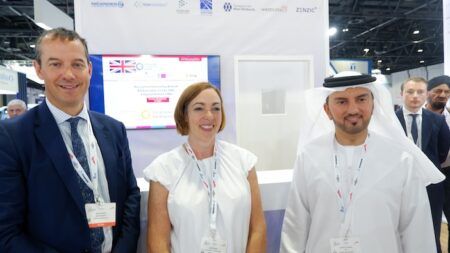This week (September 17-21), at the ITS World Congress, Eindhoven University of Technology has demonstrated eight C-ITS applications that are currently live in eight sites in Europe as part of a C-Mobile initiative.
On open roads near the Bella Center, during a 20-minute drive, visitors were shown vehicle-to-infrastructure (V2I) technologies operating in a number of theoretical applications. The car used during the demonstration was a Toyota Prius (owned by Fonty’s University of Applied Science), which had connected and autonomous capabilities added to it by the A-Team – a team created jointly by the Eindhoven University of Technology and Fonty’s University of Applied Science.
The first application to be shown is a pedestrian warning system, right, that notifies the driver of the car when a pedestrian suddenly steps out in front of it and when the path ahead of the vehicle becomes clear again. This system is made possible thanks to vehicle-to-pedestrian (V2P) technologies, in which a smartphone app (used by the pedestirans) notifies the car when the pedestrian has entered its path.
Green light optimal speed advisory (GLOSA) was a further C-ITS application to be shown – and used at several intersections during the course of the demonstration. GLOSA is used to indicate drivers of the optimum speed to travel at in order to ride the green wave and avoid having to stop at the lights. GLOSA relies on dedicated short-range communication (DSRC).
“Our vehicle is communicating via ITS G5 and cellular to send and receive information about the road warnings being shown today,” said Sander Steeghs, a student at Fonty’s University of Applied Science and a member of the A-Team, who drove the vehicle duting the demonstration.
A road hazard notification was also sent to the car during the demonstration, to notify the driver of a vehicle traveling in the wrong direction. This warning is sent to the demonstration vehicle via ETSI DENM (decentralized environmental notification messages). The demonstration vehicle was also sent a second warning – about a nearby road accident – via ETSI DEMN, above.
The use of information for drivers, sent from traffic management centers, was demonstrated by means of a closed lane warning displayed on a virtual variable message sign (VMS), below.
Throughout the demonstration, visitors were also able to see a separate human-machine interface (HMI), below, inside the car that shows its vehicle-to-vehicle capabilities. The display shows the car itself as a circle in the center. Sensors on the car depict other objects – such as other vehicles or pedestrians – around the car’s representation on-screen, according to how close they are to it in real life.
“This HMI shows that the connected vehicle-to-vehicle features of the car are working,” daid Steeghs. “It could help to build confidence in those who are not very trusting of autonomous vehicles. The HMI shows that the car has recognized other vehicles in close proximity to it, and its exact positioning on the road compared with them.”
C-Mobile projects include vehicle-to-vehicle safety, vehicle-to-infrastructure safety, parking efficiency and traffic efficiency, in locations in: Bilbao and Copenhagen, Denmark; Vigo and Barcelona, Spain; Newcastle, UK; North Brabant, the Netherlands; and Thessaloniki, Greece.




